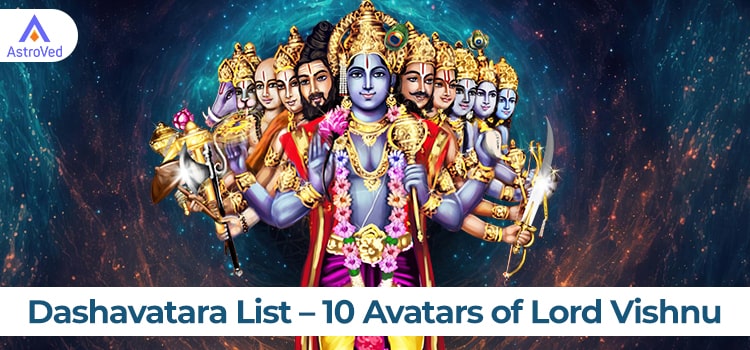In Hindu mythology, Lord Vishnu, the preserver, and protector of the universe, is believed to have incarnated on Earth in various forms or avatars to restore balance and uphold righteousness. These incarnations, known as the Dashavatara, encompass ten significant manifestations of Lord Vishnu. Each avatar carries a specific purpose and message for humanity. In this article, we will explore the ten avatars of Lord Vishnu and delve into the stories and symbolism behind each divine incarnation.

Matsya (The Fish Avatar)
Matsya, the first avatar of Lord Vishnu, appeared during the Satya Yuga, the first age of the universe. In this form, Lord Vishnu took the shape of a giant fish to save the first man, Manu, and various species of plants and animals from a catastrophic flood. Matsya warned Manu about the impending deluge and guided him to build a massive boat to ensure their survival. The Matsya avatar signifies protection, guidance, and preservation of life.
Kurma (The Tortoise Avatar)
In the second avatar, Lord Vishnu assumed the form of a gigantic tortoise called Kurma. During the churning of the cosmic ocean (Samudra Manthan) by the gods and demons, Kurma supported Mount Mandara on his back, acting as a stable foundation. This avatar symbolizes stability, strength, and the willingness to bear immense burdens for the greater good.
Varaha (The Boar Avatar)
Lord Vishnu incarnated as Varaha, a divine boar, in the third avatar. Varaha rescued the Earth, which had sunk to the depths of the cosmic ocean. He defeated the demon Hiranyaksha and lifted the Earth on his tusks, restoring it to its rightful place. The Varaha avatar represents protection, valor, and the triumph of good over evil.
Narasimha (The Half-Man, Half-Lion Avatar)
Narasimha, the fourth avatar, emerged to vanquish the demon king Hiranyakashipu. He had obtained a boon that made him virtually indestructible. Lord Vishnu, in the form of Narasimha, tore apart Hiranyakashipu with his lion-like claws during twilight, neither inside nor outside, thus fulfilling the boon’s conditions. Narasimha signifies the embodiment of divine wrath, fearlessness, and the destruction of evil forces.
Vamana (The Dwarf Avatar)
Lord Vishnu took the form of Vamana, a dwarf Brahmin, to curtail the power of the demon king Mahabali, who had become invincible through his devotion and penance. Mahabali was approached by Vamana, who requested three steps of land. When granted, Vamana grew into a gigantic form, covering the entire universe in two strides. The humble Vamana avatar teaches the lesson of humility, righteousness, and the ultimate supremacy of the divine.
Parashurama (The Warrior Sage Avatar)
Parashurama, the sixth avatar, was a warrior sage who wielded a formidable axe known as the Parashu. He appeared during the Treta Yuga to eradicate tyranny and restore balance on Earth. Parashurama rid the world of corrupt and oppressive rulers, cleansing society of evil forces. This avatar symbolizes strength, valor, and the fight against injustice.
Rama (The Ideal King Avatar)
Rama, the seventh avatar, is the protagonist of the epic Ramayana. He exemplifies the qualities of an ideal king, husband, and son. Rama’s primary purpose was to rid the world of the demon king Ravana, who had captured Rama’s wife, Sita. With the help of his loyal devotee Hanuman and an army of vanaras, Rama waged a righteous war against Ravana and ultimately emerged victorious. The Rama avatar represents righteousness, honor, devotion, and the triumph of good over evil.
Krishna (The Divine Teacher Avatar)
Krishna, the eighth avatar, is one of the most beloved and revered deities in Hinduism. He played a central role in the epic Mahabharata, imparting profound wisdom and teachings through the Bhagavad Gita. Krishna exemplified various facets of life, serving as a mischievous child, a compassionate friend, a charismatic leader, and an enlightened spiritual guide. The Krishna avatar embodies love, compassion, knowledge, and the preservation of dharma (righteousness).
Buddha (The Enlightened Sage Avatar)
In the ninth avatar, Lord Vishnu appeared as Buddha, the enlightened sage who preached non-violence, compassion, and the path to liberation from suffering. The Buddha avatar was significant in reforming social and religious practices, inspiring a spiritual revolution and emphasizing the importance of inner transformation. This avatar represents enlightenment, peace, and the pursuit of spiritual awakening.
Kalki (The Future Avatar)
The Kalki avatar is the final incarnation of Lord Vishnu, yet to manifest in the future. It is believed that Kalki will appear at the end of the current age, Kali Yuga, to restore harmony and righteousness in a world plagued by moral degradation and chaos. Kalki will ride a white horse, wielding a blazing sword, and cleanse the world of evil, paving the way for a new age of enlightenment and righteousness.
Conclusion
The Dashavatara, the ten avatars of Lord Vishnu, represent the divine interventions undertaken to restore balance, uphold righteousness, and guide humanity on the path of righteousness. Each avatar holds unique symbolism and imparts valuable lessons for devotees to emulate. From the fish avatar Matsya to the future incarnation of Kalki, Lord Vishnu’s avatars exemplify virtues such as protection, strength, humility, righteousness, compassion, and enlightenment.
Devotees revere these avatars and seek inspiration from their stories and teachings. By understanding and imbibing the virtues represented by each avatar, individuals can strive towards personal and spiritual growth, and contribute to creating a more harmonious and righteous world.
Remember, the essence of these avatars lies not only in their individual stories but also in the universal truths and principles they convey. The Dashavatara serves as a reminder of the divine presence in our lives and the eternal battle between good and evil. May the wisdom and grace of Lord Vishnu’s avatars guide us on our spiritual journey and inspire us to lead virtuous lives filled with love, compassion, and righteousness.